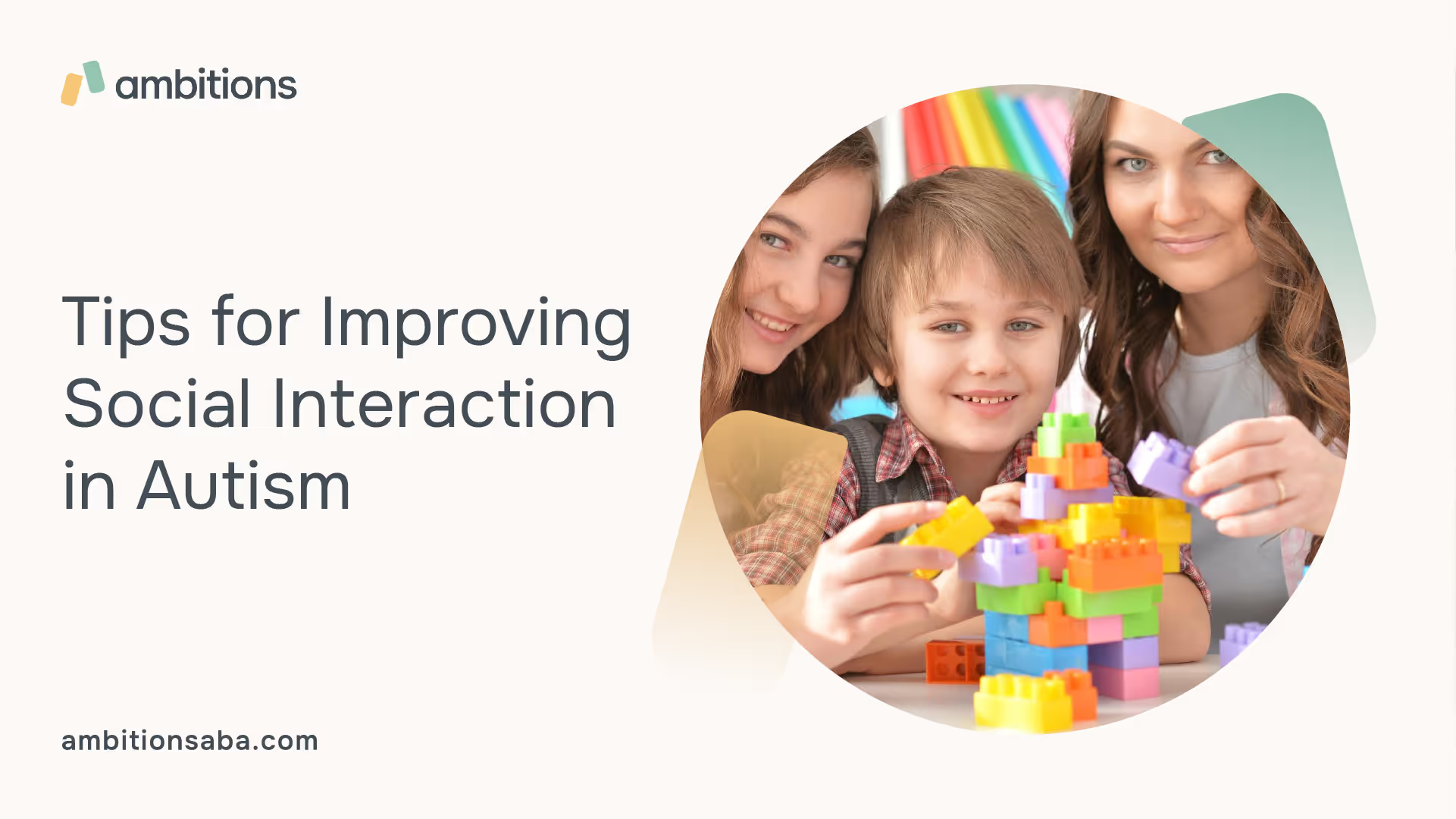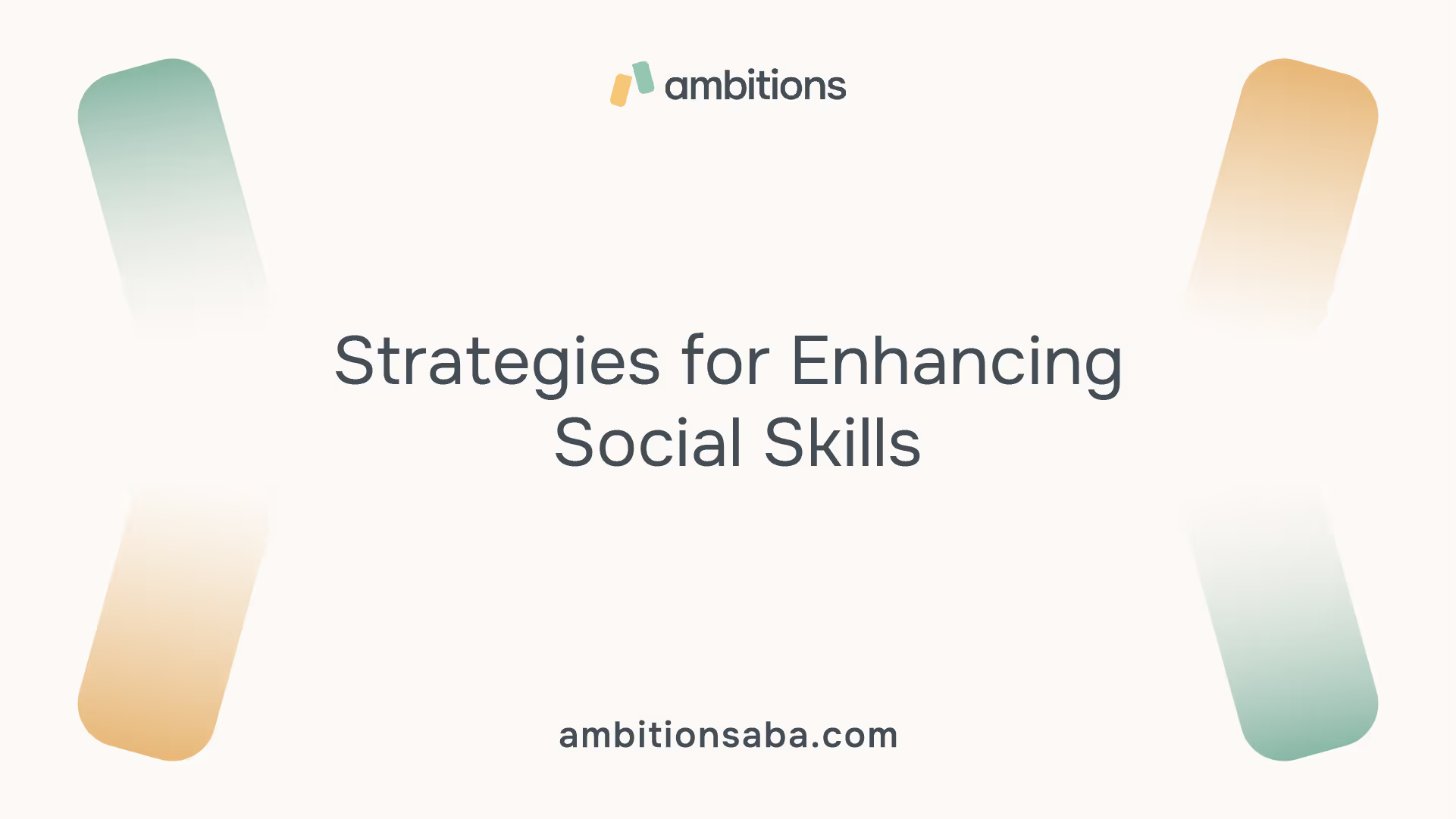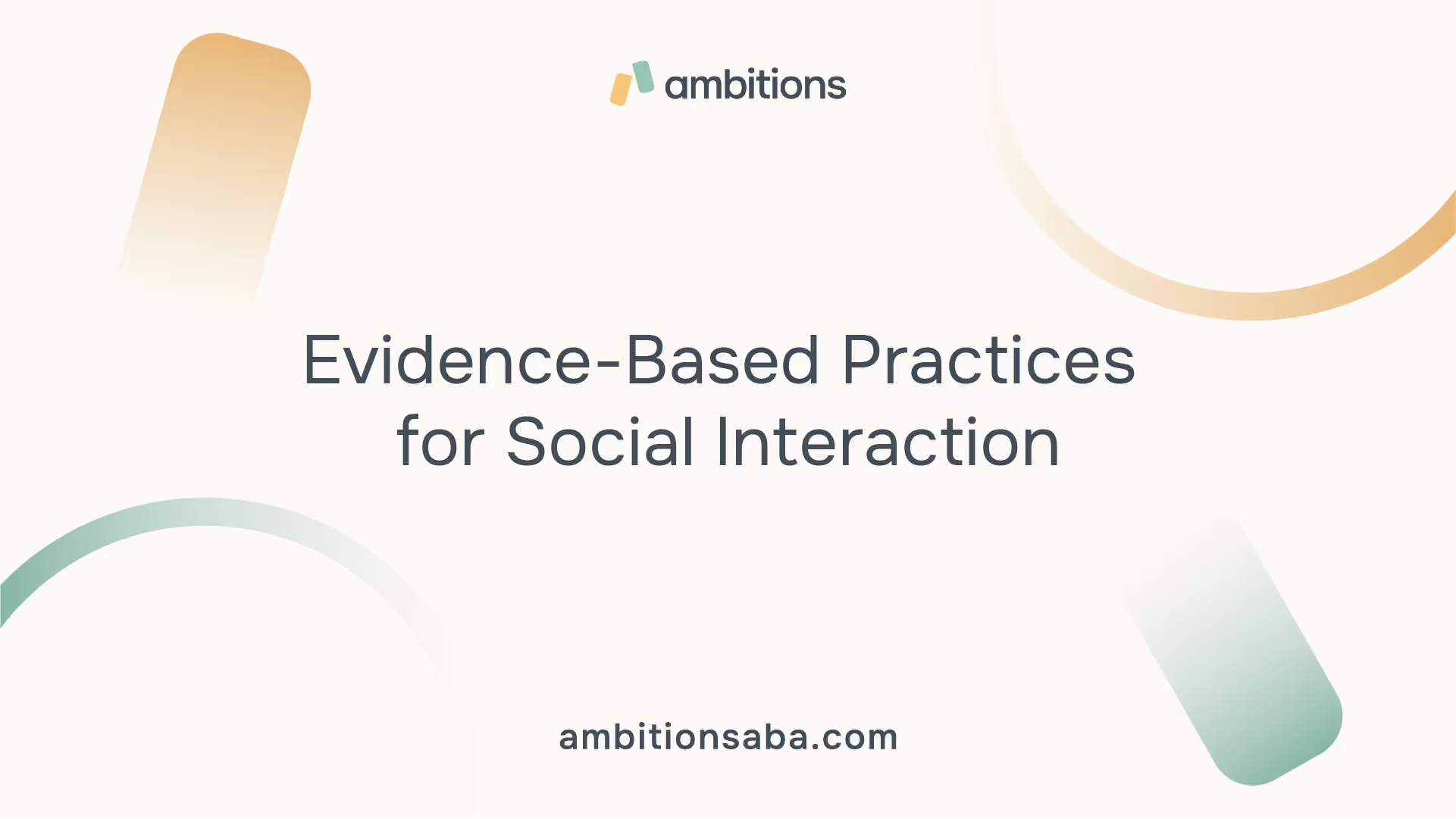A Comprehensive Guide to Applied Behavior Analysis
Understanding Social Interaction Challenges
For individuals on the autism spectrum, social interaction can present unique challenges that impact their ability to navigate social situations effectively. It is important to recognize the impact of these difficulties and understand the significance of addressing social challenges in individuals with autism.

Impact of Social Interaction Difficulties
People on the autism spectrum may find social interaction difficult, which can have wide-ranging effects on their daily lives. These difficulties can manifest in various ways, including challenges in verbal and nonverbal communication, understanding social cues, exhibiting empathy, and engaging in reciprocal social interactions.
Difficulties in communication skills, both verbal and nonverbal, can make it challenging for individuals with autism to effectively convey their thoughts, feelings, and needs. They may struggle with interpreting and using nonverbal cues such as facial expressions, body language, gestures, and eye contact. These challenges can hinder their ability to build relationships, understand others' emotions, and participate in social activities.
The impact of social interaction difficulties extends beyond interpersonal relationships. Individuals with autism may face challenges in managing conflict, problem-solving, and feeling included in social settings. These difficulties can lead to feelings of anxiety, isolation, and being misunderstood. It is essential to address these challenges to support the overall well-being and quality of life of individuals with autism [2].
Furthermore, individuals on the autism spectrum are more likely to experience bullying compared to those with other types of disabilities. Addressing social interaction challenges is crucial in creating a supportive and inclusive environment that reduces the risk of bullying and promotes positive social experiences [2].
Importance of Addressing Social Challenges
Recognizing and addressing social challenges in individuals with autism is of utmost importance. By providing support and intervention, we can help them develop and enhance their social skills, leading to improved overall functioning and well-being.
Addressing social challenges can positively impact various aspects of an individual's life. It can enhance their ability to form and maintain friendships, participate in group activities, and engage in meaningful social interactions. By improving social skills, individuals with autism can experience increased social acceptance, improved self-esteem, and a greater sense of belonging.
Moreover, addressing social interaction challenges can contribute to reducing social isolation, bullying, and mental health issues that individuals with autism may face. By creating an inclusive and supportive environment, we can foster understanding, empathy, and acceptance, promoting a more inclusive society for individuals with autism.
In the following sections, we will explore strategies and evidence-based practices that can help enhance social skills and support individuals with autism in their social interactions.
Strategies for Enhancing Social Skills
When it comes to individuals with autism, enhancing social skills is a crucial aspect of their development. By focusing on building competence in social skills and developing social understanding, individuals with autism can improve their interactions and relationships with others.

Building Competence in Social Skills
Building competence in social skills involves providing individuals with opportunities to learn and practice various social interactions. Just like academic skills, social skills can be learned and developed over time [2]. Here are some strategies to consider:
- Structured Social Skills Training: Structured social skills training programs, such as those based on applied behavior analysis techniques, can provide individuals with systematic instruction and practice opportunities. These programs focus on breaking down social skills into manageable steps and teaching them in a structured and supportive environment.
- Role-Playing and Modeling: Role-playing activities can be utilized to simulate real-life social situations, allowing individuals to practice appropriate behaviors and responses. By observing and imitating positive social interactions through modeling, individuals can gain a better understanding of expected social behaviors.
- Social Narratives: Social narratives, such as Social Stories™, are individualized narratives that describe social situations in detail, offering cues and appropriate responses. These narratives help individuals with autism develop social understanding, enhance interaction skills, and reduce anxiety by breaking down information in a literal, basic way [2].
Developing Social Understanding
Developing social understanding is another crucial aspect of enhancing social skills for individuals with autism. By providing visual supports and utilizing specific strategies, individuals can better comprehend social interactions. Here are some strategies to consider:
- Visual Supports: Visual supports, such as visual aids and schedules, can help individuals with autism understand and remember social expectations and routines. These visual tools provide structure and clarity, making social situations more predictable and manageable. Visual aids can include visual schedules, social stories, and comic strip conversations™, among others.
- Comic Strip Conversations™: Developed by Carol Gray, comic strip conversations™ use visual representations of conversations through stick figure drawings and symbols. This strategy simplifies abstract aspects of social interaction, helping individuals with autism understand conversations and emotional meanings.
By focusing on building competence in social skills and developing social understanding,
By focusing on building competence in social skills and developing social understanding, individuals with autism can navigate social interactions more effectively. These strategies, along with early intervention and applied behavior analysis techniques, can support individuals with autism in their social development journey.
Evidence-Based Practices for Social Interaction
When it comes to improving social interaction in individuals with autism, implementing evidence-based practices (EBPs) is essential. These practices have been shown to be effective in teaching appropriate behaviors and skills while decreasing inappropriate behaviors for individuals with autism spectrum disorder (ASD). Let's explore two key aspects of utilizing EBPs for social interaction: selecting appropriate practices and monitoring their effectiveness.

Selecting Evidence-Based Practices
Selecting an evidence-based practice involves a systematic approach to determine the target behavior, collect baseline data, and set goals in the individualized education program (IEP) or individualized family service plan (IFSP). Educators and practitioners should consider the specific needs and challenges of the individual with autism, focusing on practices that can effectively address the target behavior.
The National Professional Development Center (NPDC) on Autism Spectrum Disorder has identified 27 evidence-based practices for improving outcomes in individuals with ASD. These practices encompass a range of strategies, including social skills training, visual supports, and behavioral interventions. It is crucial to carefully assess the suitability of each practice for the individual's unique needs and goals.
Monitoring EBP Effectiveness
Once an evidence-based practice has been selected and implemented, it is important to monitor its effectiveness. Collecting data on the target behavior allows educators and practitioners to evaluate how well the practice is working for the individual. This data helps determine whether the practice was implemented with fidelity and whether it has produced the desired outcomes.
Monitoring the quality of implementation is crucial, as fidelity to the chosen evidence-based practice significantly impacts its effectiveness. Fidelity checklists can be used to ensure that the practice is being implemented as intended. If the practice proves to be ineffective, it may be necessary to consider alternative strategies or add additional practices to support behavior change. It is important to allow sufficient time for the evidence-based practice to have an impact on the individual's behavior before making any judgments about its effectiveness.
By selecting and monitoring evidence-based practices, educators and practitioners can enhance social interaction skills in individuals with autism. It is crucial to consider the specific needs of each individual and ensure that practices are implemented with fidelity. By doing so, we can provide effective support and create meaningful opportunities for individuals with autism to engage in social interactions. For more information on autism and applied behavior analysis techniques, please visit our article on autism and ABA therapy.
Social Skills Development Programs
For individuals with autism, social skills development programs play a vital role in improving their ability to interact and communicate with others. These programs provide structured guidance and support to enhance social skills and promote meaningful connections. Two notable programs in this field are the PEERS program at UCLA and Structured Social Skills Groups.
PEERS Program at UCLA
The PEERS program, which stands for Program for the Education and Enrichment of Relational Skills, is a renowned 16-week-long program offered at UCLA. This evidence-based program focuses on teaching social skills to individuals with autism, including tips on dating [4]. The program aims to equip participants with the necessary tools to navigate social situations, build friendships, and establish meaningful relationships.
Through a combination of didactic lessons, role-playing exercises, and real-world practice, the PEERS program addresses various aspects of social interaction. Participants learn essential skills such as initiating conversations, joining groups, handling teasing and bullying, and managing conflicts. The program also emphasizes the development of non-verbal communication skills, including body language, facial expressions, and eye contact.
Structured Social Skills Groups
Structured social skills groups are another effective approach for fostering social interaction in individuals with autism. These groups are typically offered in schools, pre-schools, or the wider community, and focus on skill development and prompting to support interaction goals. They provide a structured environment where individuals can practice and refine their social skills in a supportive setting.
In structured social skills groups, participants engage in various activities and exercises designed to enhance social understanding and interaction. These may include role-playing scenarios, practicing conversational skills, and engaging in group activities that encourage cooperation and teamwork. The groups are often facilitated by professionals who provide guidance, feedback, and reinforcement to help individuals develop and generalize their social skills.
By participating in social skills development programs like the PEERS program at UCLA and structured social skills groups, individuals with autism can gain valuable tools and strategies to navigate social situations with greater confidence. These programs foster a supportive environment for learning, practicing, and refining social skills, helping individuals with autism build meaningful connections and improve their overall quality of life.
To supplement these programs, visual supports such as social narratives and Comic Strip Conversations TM can be used to further enhance social understanding and interaction. Additionally, modeling, where desired behavior is demonstrated by parents, professionals, or peers, can aid in skill development by providing examples for learners to imitate.
Visual Supports for Social Interaction
For individuals with autism, visual supports play a crucial role in enhancing social interaction and communication skills. These visual aids help individuals process information, understand social situations, and express themselves effectively. Let's explore the benefits of visual supports and how they can be used for communication.
Benefits of Visual Supports
Visual supports, such as charts, booklets, and electronic devices, provide individuals with autism the opportunity to process information visually, which can be highly beneficial. According to Autism Speaks, visual aids, including personalized teaching stories, help individuals with autism know what to expect in different situations and learn what is expected of them. Some key benefits of visual supports include:
- Enhanced understanding: Visual aids break down information into visual cues and representations, making it easier for individuals with autism to understand social and emotional concepts.
- Reduced anxiety: By providing clear and concrete information, visual supports can help reduce anxiety in social situations, as individuals know what to expect and how to respond.
- Improved social interactions: Visual supports support individuals in recognizing and interpreting social cues, facilitating more successful social interactions.
- Support for expression: Visual aids provide individuals with a means to express themselves when verbal communication may be challenging.
Using Visual Aids for Communication
Visual aids offer various methods for individuals with autism to communicate effectively. Here are some commonly used visual aids:
- Communication boards: Communication boards are visual tools that enable nonverbal individuals with autism to express themselves by pointing or gesturing at images. These images can range from photographs and illustrations to symbols. Communication boards can be as simple as bulletin boards or as sophisticated as digital devices.
- Picture Exchange Communication System (PECS): PECS is a communication approach that uses images to represent thoughts and requests. It allows children with autism to communicate specific needs efficiently by selecting and exchanging pictures with therapists, family members, or others.
- Social narratives: Social narratives, such as Social Stories™, are personalized narratives that describe social situations in detail and offer cues and appropriate responses. These narratives break down information in a literal and basic way, helping individuals with autism develop social understanding, enhance interaction skills, and reduce anxiety.
By incorporating visual supports into social interaction and communication, individuals with autism can better navigate social situations, express themselves, and engage more meaningfully with others. It's important to tailor visual supports to the individual's needs and preferences, ensuring that they are effective and meaningful for their unique circumstances.
For additional strategies and techniques related to autism and social skills, you may find our articles on applied behavior analysis techniques, behavior intervention plan (BIP) benefits, and the benefits of social skills training for autism helpful.
Supportive Family and Friend Relationships
In the journey of navigating autism, the support of family and friends plays a crucial role in the well-being of both the child and the family as a whole. Extended family and friends can be key parts of the informal support network for families with autistic children and teenagers. It is essential to help family and friends understand what autism means for the child and the family, especially in the period following the diagnosis [5].
Extended Family Support
The involvement and support of extended family members can provide valuable assistance to parents of autistic children. Communicating the needs of the child and the family to extended family members can help them provide appropriate support. Simple gestures like cooking a meal, taking the parents out for coffee, babysitting, or providing a listening ear when needed can make a significant difference in the lives of the family.
By understanding and accepting the unique challenges that autism presents, extended family members can contribute to a positive and supportive environment for the child. Their willingness to learn about autism and engage in the child's therapy and educational journey can foster stronger bonds within the family.
Role of Grandparents
Grandparents of autistic children may experience a range of emotions upon receiving the diagnosis, including surprise, confusion, and concern for the well-being of the family. However, many grandparents also exhibit resilience, unconditional love, and strong support for their families. Their involvement in the lives of their grandchildren can provide them with a sense of belonging and aid in the construction of self-identity [5].
It is important for grandparents to communicate openly with the child's parents and seek a deeper understanding of autism. Attending therapy sessions, engaging in discussions with health professionals, and participating in the child's development can strengthen family relationships. By being actively involved, grandparents can contribute to the child's growth, development, and overall well-being.
Grandparents who have concerns about the diagnosis or how to support their grandchild can benefit from seeking guidance from the child's health professionals. Open communication, empathy, and a willingness to learn can foster happier, healthier, and stronger family relationships, ultimately benefiting the autistic child.
By cultivating supportive relationships with extended family and friends, parents of autistic children can create a network of understanding and care. The involvement of grandparents can bring unique perspectives and experiences that contribute to the overall well-being of the child and the family. Together, these relationships form a strong foundation of support as the family navigates the challenges and joys of raising a child with autism.
Overcoming Social Isolation
For individuals on the autism spectrum, social interaction challenges can often lead to feelings of social isolation. However, there are strategies and techniques that can help address this issue and promote meaningful connections with others. In this section, we will explore ways to address social isolation and provide strategies for making friends.
Addressing Social Isolation
Social isolation can occur for various reasons, such as feeling unwelcome, enjoying solitude, lacking confidence or skills to engage with others, experiencing past negative experiences like bullying, needing higher levels of support, living independently, or being unaware of local activities. It's important to recognize and address these factors to overcome social isolation.
Planning and developing social interactions can be facilitated by gradually introducing changes, focusing on places to meet new people, and practicing small talk to reduce anxiety in making contact with others. Seeking support from a GP or qualified counselors who understand autism can also be beneficial in reducing anxiety and developing social skills.
Strategies for Making Friends
Making friends can be a rewarding experience, and there are strategies that can help individuals on the autism spectrum build connections with others. Here are some tips for making friends:
- Join social groups with similar interests: Engaging in activities or joining social groups that align with your interests can provide opportunities to meet like-minded individuals. This shared interest can serve as a foundation for developing friendships.
- Find local support groups: Connecting with local support groups can provide a supportive environment where individuals with autism can meet others who understand their experiences. These groups often organize social events and activities that facilitate social interactions.
- Engage in activities and learn new skills: Participating in activities or learning new skills can bring individuals together and create opportunities for social interactions. Consider engaging in hobbies or taking classes where you can meet and interact with others who share similar interests.
- Prepare questions or introductions: When meeting new people, having prepared questions or introductions can help initiate conversations. Starting with common topics like weather, TV shows, music, or weekend activities can make it easier to connect with others.
- Be aware of social cues: Understanding social cues and signals is important in maintaining conversations and building relationships. Pay attention to non-verbal cues and be mindful of signs that someone may want to end a conversation.
Remember, building friendships takes time and effort. It's important to be patient and not get discouraged if the process takes longer than expected. With practice and persistence, individuals on the autism spectrum can develop meaningful connections and overcome social isolation.
By addressing social isolation and implementing strategies for making friends, individuals on the autism spectrum can enhance their social interactions and improve their overall well-being. Supportive family and friend relationships, along with the utilization of visual supports and evidence-based practices, can further contribute to the development of strong social skills.
References
[1]: https://educationonline.ku.edu/community/social-difficulties-in-autism-spectrum-disorder
[2]: https://thespectrum.org.au/autism-strategy/social-interaction/
[3]: https://iris.peabody.vanderbilt.edu/module/asd2/cresource/q1/p02/
[4]: https://www.autismspeaks.org/social-skills-and-autism
[5]: https://raisingchildren.net.au/autism/communicating-relationships/family-relationships/family-friends-asd
[6]: https://www.autism.org.uk/advice-and-guidance/topics/family-life-and-relationships/making-friends/autistic-adults

